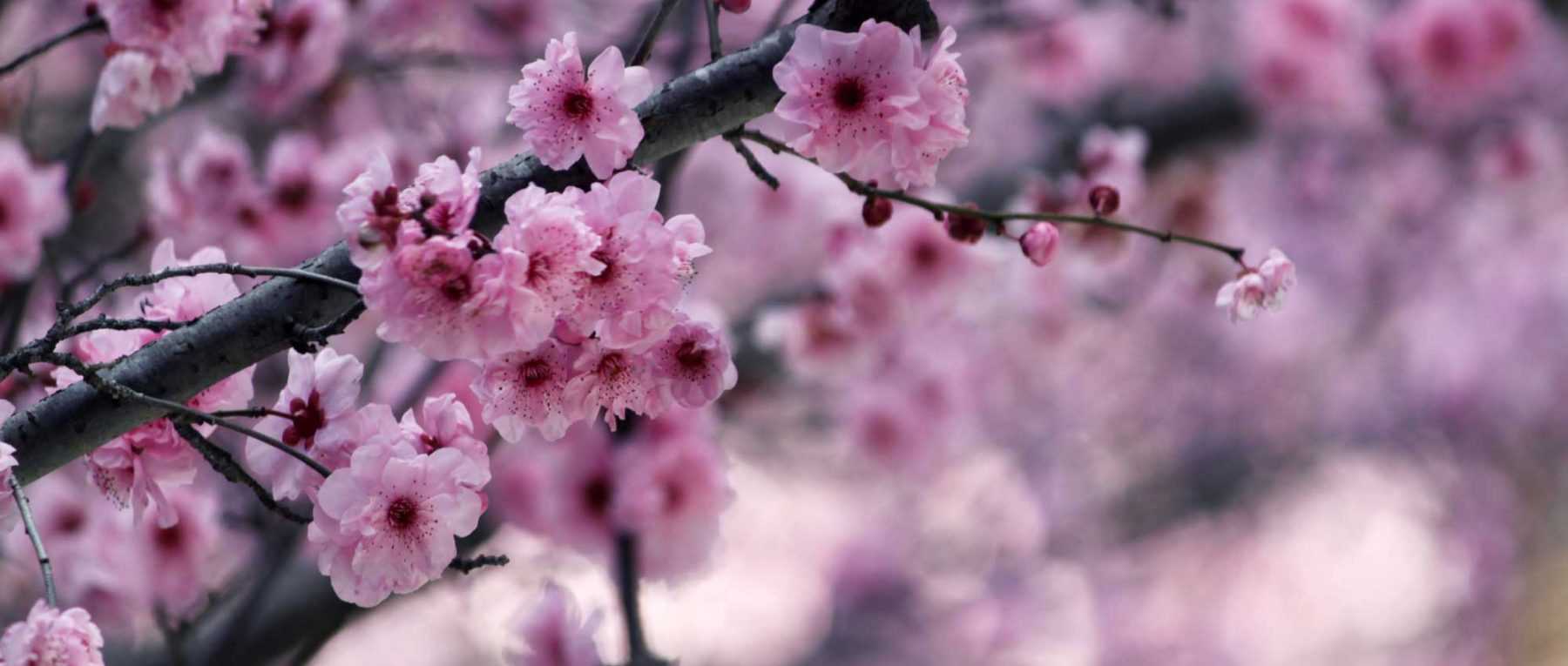
Japanese Cherry Trees: Planting, Pruning and Care
Contents
Japanese Cherry Trees in a Nutshell
- Japanese cherry trees offer an abundance of pink or white flowers in spring!
- The flowers can be single or double, solitary or clustered in bouquets… but they’re always delicate and elegant!
- Their foliage changes hue throughout the seasons, often turning red or orange in autumn
- They can have rounded, upright or weeping forms, with compact varieties suitable for container growing.
- The bark is highly decorative, smooth and marked with horizontal striations
Our Expert's Word
Japanese Cherry Trees, also known as Flowering Cherries, offer a truly spectacular display of blooms in early spring. They herald the return of spring and warmer days by covering themselves in a multitude of delicate pink or white flowers. The Japanese cherry is a small tree that marks the changing seasons: with spectacular flowering in early spring, foliage that turns beautiful colours in autumn before falling, revealing decorative, smooth bark with horizontal striations in winter.
Flowering cherry trees hold great cultural significance in Japan, where they are called Sakura. Each spring, they inspire a ritual called Hanami, where people gather under the cherry trees for picnics. Highly symbolic, the cherry tree represents the ephemeral nature of beauty and life. It has an extremely poetic and delicate quality.
Japanese cherry trees offer great diversity in their overall form, with some varieties having upright or weeping habits. There are also dwarf, compact cherry trees suitable for container growing, which can even be trained as bonsai! Although they encompass several species, the most commonly cultivated flowering cherries in France are Prunus serrulata.
Botany
Botanical data
- Latin name Prunus serrulata
- Family Rosaceae
- Common name Japanese cherry, Flowering cherry
- Flowering Spring
- Height typically between 2 and 8 metres
- Exposure full sun
- Soil type deep, fresh and well-drained
- Hardiness between –15 and –20 °C
Japanese cherry trees are trees and shrubs that herald the arrival of spring by covering themselves in a multitude of pink or white flowers. They have deciduous foliage, which usually takes on beautiful hues in autumn. They include several different species: Prunus serrulata, Prunus x subhirtella, Prunus incisa, Prunus glandulosa… The most common species is Prunus serrulata, a tree native to Japan and China. It should not be confused with the Tibetan cherry, whose Latin name is very similar: Prunus serrula. In Japan, flowering cherries are called Sakura.
The genus Prunus includes around 250 species of trees and shrubs. It includes plums, peaches, almonds, apricots… and also the cherry laurel, Prunus laurocerasus, commonly grown as a hedge. All these plants belong to the large Rosaceae family, which includes most fruit trees and a great many horticultural and wild plants. Japanese cherries have been widely hybridised, and there are now very many horticultural varieties, which produce more sophisticated flowers, sometimes double.
Japanese cherry trees grow quickly. They typically reach between 2 and 8 metres in height. Some have a compact habit and are well suited to small gardens, such as Prunus glandulosa, which does not exceed 1.50 m in height and spread, while other varieties can reach 12 metres in height.
Japanese cherry trees have an upright habit, and over time, the branches and twigs tend to spread out, giving the crown a fairly horizontal, flattened shape. Some varieties have a much narrower shape, with branches close to the trunk, such as Prunus ‘Amanogawa’. The habit can also be weeping, as in Prunus ‘Kiku Shidare Sakura’ or Prunus subhirtella ‘Pendula’. As for Prunus glandulosa, it forms a shrub with a bushy habit. Japanese cherry trees can be grown as bonsai: Prunus incisa ‘Kojo No Mai’ is one of the most suitable varieties for this purpose.
The Japanese cherry has beautiful decorative bark, smooth and marked with lenticels (pores on the bark that allow exchanges between the atmosphere and the plant), giving horizontal striations. The branches of the flowering cherry ‘Kojo No Mai’ are twisted: they grow in a zigzag pattern. Other species related to Japanese cherries, such as Prunus serrula or Prunus maackii, have exceptional bark.
The Japanese cherry blooms from early spring, around April. The flowering usually appears before the leaves, sometimes at the same time as them. Prunus glandulosa are among the latest to flower, often in May. Prunus ‘Accolade’ flowers early, from March. The Japanese cherry is a symbol of ephemeral beauty, as the flowers last only a short time. However, it produces such a quantity of flowers that those that fall to the ground are also very decorative, sometimes forming real pink or white carpets at its base. The ideal is perhaps to combine different varieties, late and earlier, to enjoy them for much longer! Prunus ‘Autumnalis Rosea’ stands out for its flowering which begins in autumn and can last until spring if temperatures are mild enough.


Prunus serrulata ‘Amagi Yoshino’, Prunus x subhirtella ‘Autumnalis Rosea’ (photo W Cutler) and Prunus glandulosa ‘Rosea Plena’ (photo V Paul W)
The Japanese cherry tree is covered in countless pink or white flowers in spring. A very pure hue that brings a touch of innocence and poetry to the garden. The flowers are so numerous that they cover everything! They hide the branches with a veil of soft pink, extremely light.
The flowers of the Japanese cherry are usually soft pink. The hue can also be more pronounced, dark pink, and there are varieties with white flowers, such as Prunus glandulosa ‘Alba Plena’. Sometimes, the flowers are pink and then lighten over time, becoming almost white. Prunus yedoensis has superb white flowering, slightly pink. It has a very ethereal appearance, the crown resembling a real cloud. The flowers can be solitary or gathered in clusters of up to five flowers.
Usually, the flowers have five petals and five sepals. But there are also varieties with double, semi-double or very double flowers. When the flowers have several rows of petals, they tend to resemble pom-poms. Those with only five petals have a very sober and elegant side. The stamens, located in the centre of the flower, are then clearly visible. On double-flowered varieties, it is the stamens that have been replaced by additional petals. The flowers are usually between 2 and 5 centimetres in diameter. Those of Prunus yedoensis are among the largest, while they are much smaller in Prunus glandulosa, measuring only between 0.5 and 1 centimetre in diameter. The flowers of Japanese cherry trees have an extremely delicate and light, very pure and refined side. Some varieties are pleasantly fragrant, such as Prunus serrulata ‘Amanogawa’.
The leaves of the Japanese cherry are simple, elliptical, toothed at the edges. They are arranged alternately on the branches (one leaf after another). They measure between 4 and 12 centimetres in length. The foliage of the Japanese cherry is deciduous: the tree therefore loses its leaves in autumn to make new ones in spring. However, it remains decorative in winter thanks to its bark and particular architecture.
The foliage of Japanese cherry trees is usually green, but in the variety ‘Royal Burgundy’, it has a beautiful deep purple hue, very intense. The leaves tend to change colour with the seasons. In some varieties, they are yellow or bronze when young, in spring. They then turn green in summer, and often take on superb red or orange hues when autumn arrives.


The foliage of Prunus serrulata ‘Kalmthout’ (photo Jean-Pol Grandmont), the purple foliage of Prunus serrulata ‘Royal Burgundy’ (photo Krzysztof Ziarnek, Kenraiz) and the autumn foliage of Prunus ‘Okame’
After flowering, Japanese cherry trees (botanical species) produce small rounded fruits, which resemble cherries but have no culinary interest. They are usually less than one centimetre in diameter and consist of little flesh but a large stone. Most horticultural varieties are sterile and therefore do not produce fruit.
The main varieties of Japanese Cherry Trees
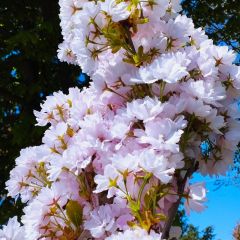
Prunus serrulata Amanogawa - Japanese Cherry
- Flowering time May, June
- Height at maturity 6 m
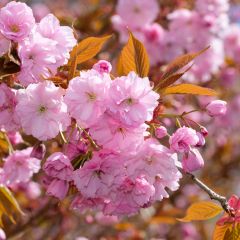
Prunus serrulata Kanzan - Japanese Cherry
- Flowering time May, June
- Height at maturity 6 m
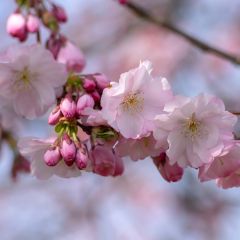
Prunus Accolade - Cherry
- Flowering time April, May
- Height at maturity 5 m
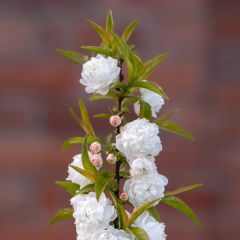
Prunus glandulosa Alba Plena - Dwarf flowering Almond
- Flowering time June
- Height at maturity 1,50 m
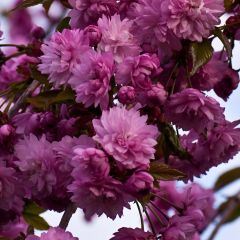
Prunus serrulata Kiku-Shidare-Zakura - Japanese Cherry
- Flowering time May, June
- Height at maturity 3,50 m
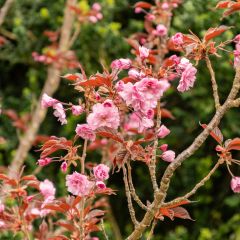
Prunus serrulata Royal Burgundy - Japanese Cherry
- Flowering time May, June
- Height at maturity 5 m
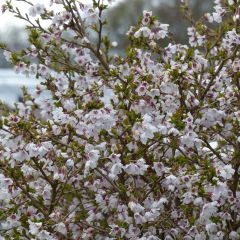
Prunus incisa Kojo-No-Mai - Cherry
- Flowering time April to June
- Height at maturity 2,50 m

Prunus Autumnalis Rosea - Cherry
- Height at maturity 5 m
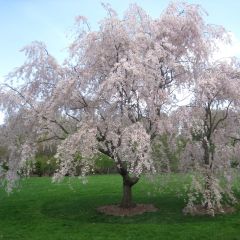
Prunus subhirtella Pendula Rubra - Wheeping Cherry
- Flowering time April, May
- Height at maturity 4 m
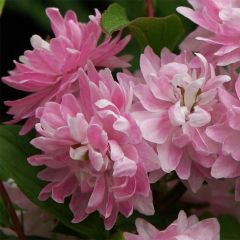
Prunus glandulosa Rosea Plena - Dwarf flowering Almond
- Flowering time May, June
- Height at maturity 1,50 m
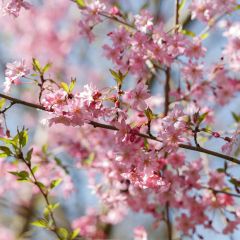
Prunus subhirtella Fukubana - Winter-flowering Cherry
- Flowering time April, May
- Height at maturity 3,50 m
You can also enjoy other trees and shrubs that resemble Japanese cherry trees and also offer white or pink blooms in spring: discover the flowering almonds (Prunus triloba), the flowering peaches (Prunus persica), the flowering plums (Prunus cerasifera) or the Tibetan cherries (Prunus serrula)…
Discover other Prunus
Planting
Where to plant?
It is important to carefully choose the location for your flowering cherry tree, as this will determine its longevity and resistance to disease. Give it enough space and optimal growing conditions to enjoy it for many years! Plant it in direct but not scorching sunlight. If you live in the Mediterranean region, opt for a slightly shaded spot, at least during the hottest hours of the afternoon.
Place it in cool, well-drained soil. Japanese cherry trees dislike waterlogged conditions, which encourage disease. If you live in a rainy area, consider planting on a mound or slope to allow water to drain away. Similarly, if your soil is heavy or clay-based, we recommend improving drainage by adding gravel or pumice at planting time.
Avoid planting Japanese cherry trees in strongly acidic soil. They prefer neutral or slightly alkaline conditions. They also need deep, fairly rich soil with plenty of organic matter. We advise digging a generous planting hole and adding well-rotted compost before placing the tree.
Choose a sheltered spot away from strong winds, as these can damage the blossoms of early-flowering varieties. The flowers are quite sensitive to cold winds. Allow enough space for the tree’s future growth—some Japanese cherry trees can reach up to ten metres in spread… Choose a variety suited to your garden’s size!
Don’t hesitate to plant it as a standalone feature, for example in the middle of a lawn: this will showcase its structure and blossoms beautifully. You can also grow it as part of a hedge with other shrubs, or in a row. Planting several Japanese cherry trees together will create an even more spectacular spring display! They also work well at the back of a border. Finally, more compact varieties like ‘Kojo No Mai’ can be grown in pots, for example on a terrace. Choose a large container and add a drainage layer at the bottom. Varieties of Prunus incisa (including ‘Kojo No Mai’) can also be planted in rockeries!
→ Learn more about growing ornamental cherry trees in pots
When to plant?
It’s best to plant Japanese cherry trees in autumn. This gives them time to establish before winter so they can flower in spring. If your tree is container-grown, it can be planted year-round, except during frost or extreme heat.
How to plant?
If you live in a rainy area, we recommend planting Japanese cherry trees on a mound to avoid waterlogging, which encourages disease.
- Soak the root ball in a bucket of water.
- Dig a planting hole, at least 60 cm wide and deep. Add a drainage layer at the bottom (especially in heavy clay soil) using gravel or pumice to improve water flow. Also add well-rotted compost.
- Gently tease out the roots by loosening the soil around the root ball.
- Place the root ball, positioning the plant’s crown at soil level.
- Insert a stake.
- Backfill with soil and firm down.
- We recommend creating a watering basin around the base of the tree to make watering easier.
- Water thoroughly.
- Apply a mulch layer around the base.
For the first few weeks after planting, water regularly to keep the soil moist. Be vigilant during the first year—don’t hesitate to water when the soil dries out.
If growing your Japanese cherry tree in a pot, choose a large container and add a layer of gravel at the bottom for drainage. Use a mix of compost and garden soil, adding some sand. Plant the tree and water well.
Maintenance
We recommend watering your Japanese Cherry Tree regularly during the first few years. After that, you can water occasionally during periods of intense heat. Don’t hesitate to mulch by placing a layer of wood chips (BRF) or dead leaves around the base of the tree. This will help the soil retain moisture for longer. You can also add well-rotted compost in autumn to nourish the plant and encourage flowering. The Japanese Cherry Tree should be staked during its early years to ensure the trunk grows straight.
Where possible, it’s best not to prune the Japanese Cherry Tree, as pruning creates wounds that can become entry points for disease. If your shrub has a balanced and harmonious shape, avoid interfering. It’s important to choose a variety whose mature size suits your garden, so you won’t need to restrict its growth by pruning. If necessary, you can carry out light pruning by trimming the ends of branches and removing any dead, damaged, or poorly positioned ones. Ideally, do this in late summer or autumn. Use sterilised tools and apply pruning sealant to the wounds afterwards. This will prevent gumming (the secretion of an amber-coloured “resin” on the cuts).
→ Learn more with Ingrid in our tutorial: How to prune a Japanese Cherry Tree?
The Japanese Cherry Tree is susceptible to blossom wilt (moniliosis). This fungal disease thrives in damp spring weather. Affected shoots dry out, and leaves and flowers wilt. Remove and burn damaged shoots immediately. It can also be affected by Coryneum, a fungal disease also known as shot hole. The foliage appears covered in small holes surrounded by brown spots. Cut away and burn infected parts of the plant, then treat with sulphur. The flowering cherry is also vulnerable to bacterial canker, caused by Pseudomonas bacteria. The bark becomes sunken, distorted, and oozes gum. As a preventive measure, you can protect your trees from diseases and pests by applying whitewash (lime-based paint).
Japanese cherry trees are also susceptible to honey fungus (armillaria), a serious disease caused by a fungus. It attacks the roots and base of the trunk, causing rot. It mainly affects already weakened trees and thrives in damp soil (hence the importance of good drainage!). There is no cure for this disease, only preventive measures (avoid injuring the tree, make clean cuts, and apply sealant to aid healing). If your flowering cherry is infected, it’s best to remove it and dig out the surrounding soil to a depth of about 50 cm. Avoid replanting another tree in the same spot, as the fungus remains in the soil.
Black aphids or scale insects may also attack the Japanese Cherry Tree. Aphids settle on the foliage and suck sap by piercing the epidermis. This weakens the plant and damages the leaves, which tend to curl and dry out. Aphids also encourage sooty mould, a harmless but unsightly condition where leaves become covered in a black, soot-like deposit. To control aphids, you can spray the foliage with insecticidal soap.
→ Learn more in our guide: Diseases and pests of flowering cherry trees.
Propagation
Grafting
The Japanese cherry tree is propagated by grafting. The wild cherry Prunus avium is commonly used as the rootstock. You can bud graft in summer, between July and September. Cleft grafting or notch grafting is carried out in early spring, in March or April.
- For bud grafting, start by preparing the rootstock by making a T-shaped cut on the trunk, about ten centimetres high. You should open the bark without cutting into the wood (you’ll feel resistance when the blade reaches the wood).
- Next, cut a branch from the variety you wish to propagate (scion). Carefully remove a well-formed bud by making a delicate incision in the bark. There should be no wood behind the scion; if there is, remove it.
- Then, lift the flap on the rootstock and insert the bud. Trim the top edge if it protrudes.
- Bind the graft point, leaving the bud exposed. It should begin to develop the following spring.
→ Learn more in Ingrid’s tutorial: How to propagate the Japanese cherry tree?
Association
Create a beautiful spring scene by pairing your Japanese cherry trees with other plants that bloom at the same time. At the end of winter, your garden will awaken with a stunning display of colour! Consider early-flowering spring bulbs, such as grape hyacinths, tulips, daffodils, or hyacinths… and perhaps other spring perennials like wood anemones. Alternatively, you can stagger flowering times to extend the display—while less dramatic, this ensures your garden remains in bloom for longer! In any case, don’t hesitate to plant Japanese cherry trees as a backdrop to flower beds. They’ll add height behind smaller perennials. Complement them with decorative foliage plants like ferns, hostas, or ornamental grasses.
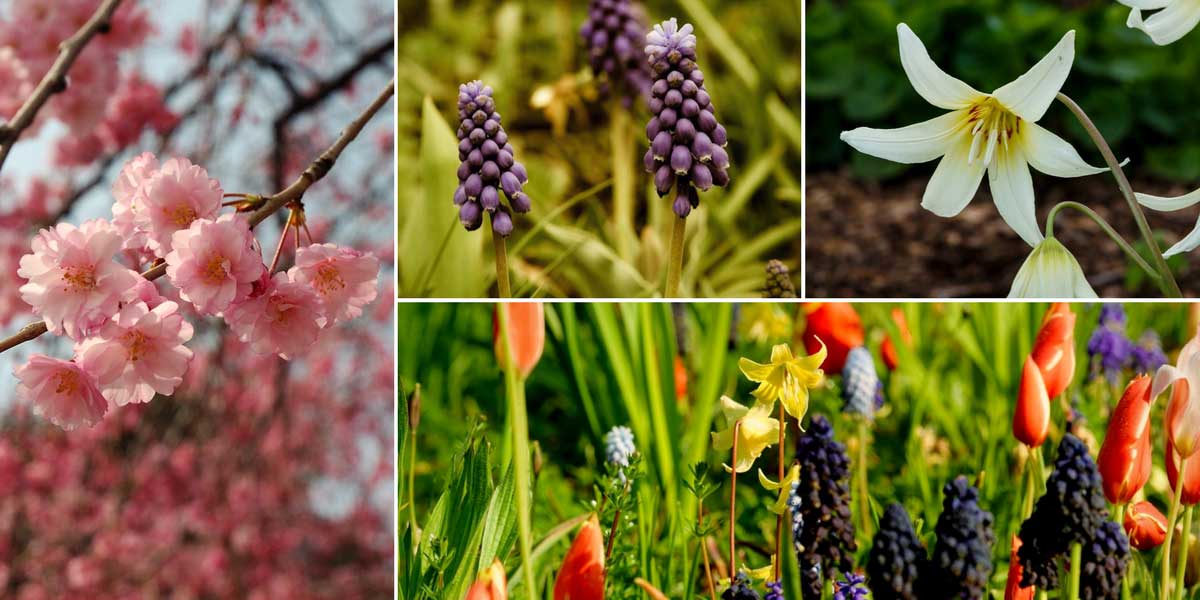

Plant spring bulbs beneath your Japanese cherry tree! Prunus serrulata (photo Kropsoq) / Grape hyacinths / Erythronium tuolumnense ‘White Beauty’ / Scene with Erythronium ‘Pagoda’, grape hyacinths, and tulips (photo iBulb – Steven Bemelman)
With their spectacular blooms and elegant structure, Japanese cherry trees shine as standalone specimens. They don’t necessarily need companion plants—isolating them often enhances their beauty. We recommend this approach for larger varieties, while compact, shrubby types integrate more easily into mixed borders.
Combine different Japanese cherry varieties to extend the flowering season! While individual trees bloom briefly, pairing early- and late-flowering cultivars ensures weeks of colour. Prunus subhirtella ‘Autumnalis Rosea’ even flowers from autumn through spring in mild weather! The ‘Accolade’ variety blooms as early as March, while Prunus glandulosa flowers later. Mix and match for prolonged enjoyment!
Why not design a Japanese-inspired border around your flowering cherry? Create a serene atmosphere with ferns, cloud-pruned pines, Japanese maples, bamboos, or Hakonechloa macra. Add a few acid-loving plants (azaleas, camellias…), but avoid overcrowding—the space should feel Zen, with room for the eye to wander. Incorporate mineral elements (rocks, stepping stones, gravel) and water features (a pond or fountain) for authenticity.
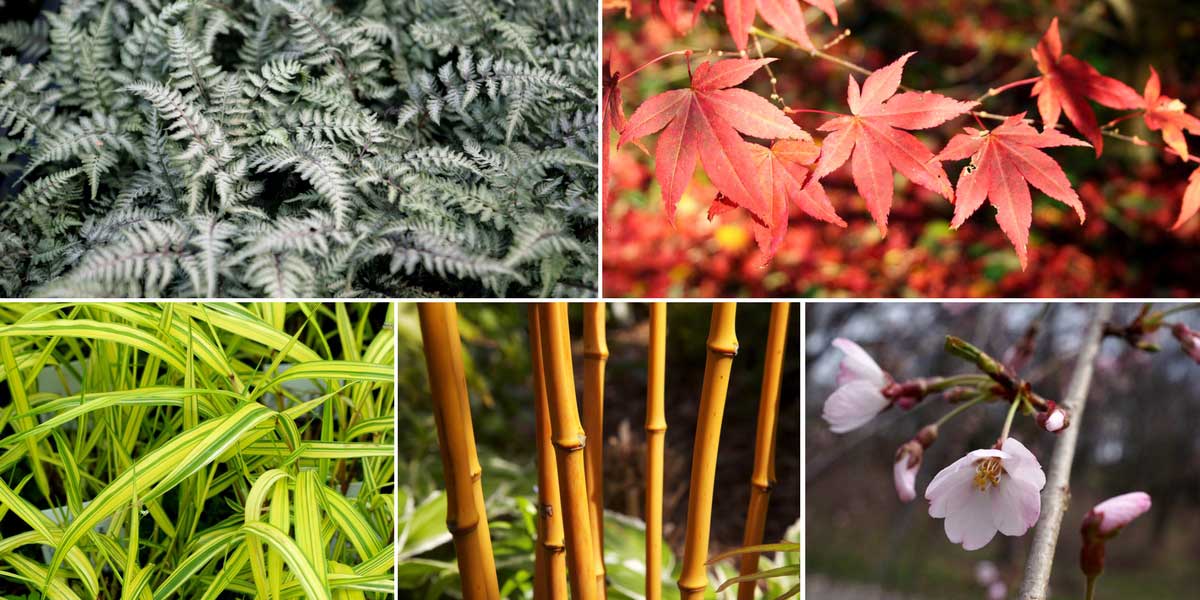

Use flowering cherries to evoke Japan in your garden! Athyrium niponicum ‘Pewter Lace’ / Acer palmatum ‘Atropurpureum’ (photo Jean-Pol Grandmont) / Hakonechloa macra ‘Aureola’ / Phyllostachys aurea (photo La Gaviotera et Xavier Claise) / Prunus yedoensis ‘Shidare Yoshino’
Integrate Japanese cherries into shrub borders or hedges alongside decorative foliage or spring-flowering plants. Pair them with viburnums, hawthorns, hornbeams, or evergreen ceanothus. Enjoy the fragrance of Viburnum burkwoodii! For cottage-style hedges, include evergreens like laurustinus (Viburnum tinus). Opt for bushy cherry varieties like Prunus glandulosa or Prunus ‘Kojo No Mai’.
Train climbers up your cherry tree’s trunk! Plant clematis (e.g., evergreen Clematis armandii), jasmine, honeysuckle, or a climbing rose at its base—these will add winter interest once the cherry loses its leaves.
→ Explore more ideas in 10 Japanese Cherry Pairing Tips from Leïla!
Did you know?
- As bonsai
It is possible to create bonsai with Japanese cherry trees. Choose a variety like ‘Kojo No Mai’, as it has a compact habit, is suitable for container growing, and its twisted branches make it easier to achieve beautiful bonsai shapes.
- Hanami
This is the Japanese custom of admiring Japanese cherry blossoms, called Sakura, in spring. It is a true ritual during which the Japanese visit parks and picnic under the cherry trees. This event lasts two weeks, but the start date obviously varies depending on the weather: it can be tracked through a kind of “weather forecast”, the Sakura zensen, which announces flowering predictions. In Japan, the most popular cherry tree is the Yoshino, Prunus yedoensis.
- In cooking
Japanese cherry blossoms are edible. In Japan, they are used to flavour dishes, desserts, herbal teas or ice creams… The flowers are often preserved in salt, and are then called shiozakura. You can also use the petals as they are to decorate dishes. The leaves can also be used: in Japan, they are pickled and sometimes used to flavour rice.
- A highly symbolic flowering!
The cherry blossom has great cultural significance in Japan. It symbolises ephemeral beauty and impermanence. With its extremely fragile and delicate, poetic appearance, it also represents the beautiful but very short side of life. It is a symbol for the Samurai, and was widely used during the Second World War to unite the Japanese people and encourage soldiers to die for their country. The government reinforced the belief that soldiers’ souls would be reincarnated as cherry trees. For students, the cherry blossom also symbolises success in exams.
Useful resources
- Discover our range of ornamental cherry trees!
- Our video advice – Planting a shrub
- Our advice on Flowering Cherry Trees, the most beautiful varieties, and Which white-flowering ornamental cherry trees to choose for your garden?
- Marion’s advice sheet: Growing a Japanese Cherry Tree in a pot
- How to choose the right ornamental cherry tree? Our buying guide to find the best flowering cherry variety
- Book – Japanese Cherry Trees and Other Ornamental Prunus, by Franck Sadrin, published by Éditions Ulmer (2014)
- Advice sheet: Diseases and pests of cherry trees
Frequently asked questions
-
The leaves of my Japanese cherry tree are full of small holes! What should I do?
It is affected by Coryneum, a fungus that causes holes with brown edges to appear on the leaves. The leaves eventually fall off. We recommend cutting off the affected parts and burning them, then treating with sulphur or Bordeaux mixture.
-
The leaves and twigs are drying out!
Your tree is likely affected by brown rot. This fungal disease is encouraged by damp weather in spring, during flowering. Prune the affected branches and then apply pruning sealant to aid healing. Treat using Bordeaux mixture or a horsetail decoction.
-
My cherry tree has a sticky, amber-coloured gum on its branches
After an injury, poorly healed pruning or a parasite attack, the plant defends itself by producing a natural gum with a translucent, brown-yellow appearance. The tree is attacked by bacteria and tries to fight them by producing this substance. This disease is called gummosis. You can treat it using Bordeaux mixture, possibly mixed with clay and applied to the wound. As a preventive measure, to avoid the appearance of gum, it is best not to prune the Japanese Cherry or to carry out only light pruning and then apply wound sealant to the cuts. Also avoid pruning in spring.
-
The leaves of my Japanese Cherry Tree are curling up on themselves
It is likely infested with black aphids. The leaves may fall off, and you might notice the appearance of sooty mould (a black substance on the foliage caused by a fungus). You can treat it using black soap.
- Subscribe!
- Contents



































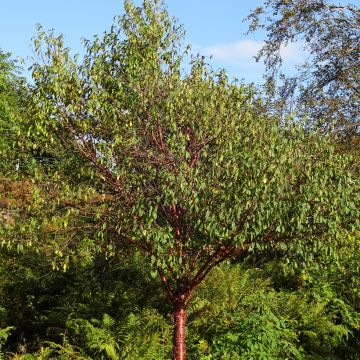



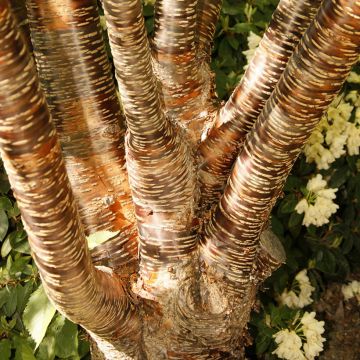
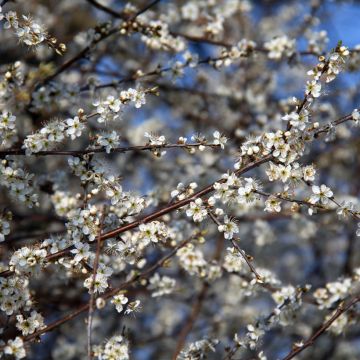








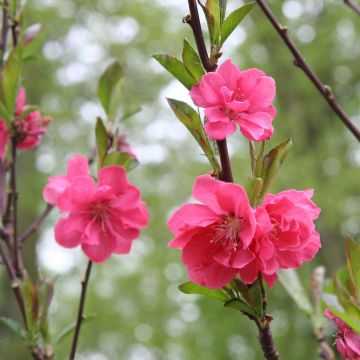
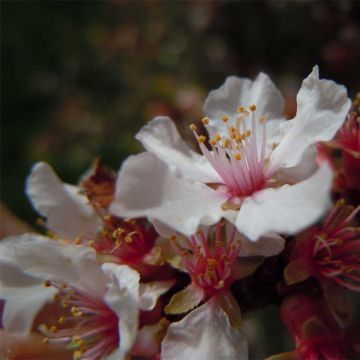
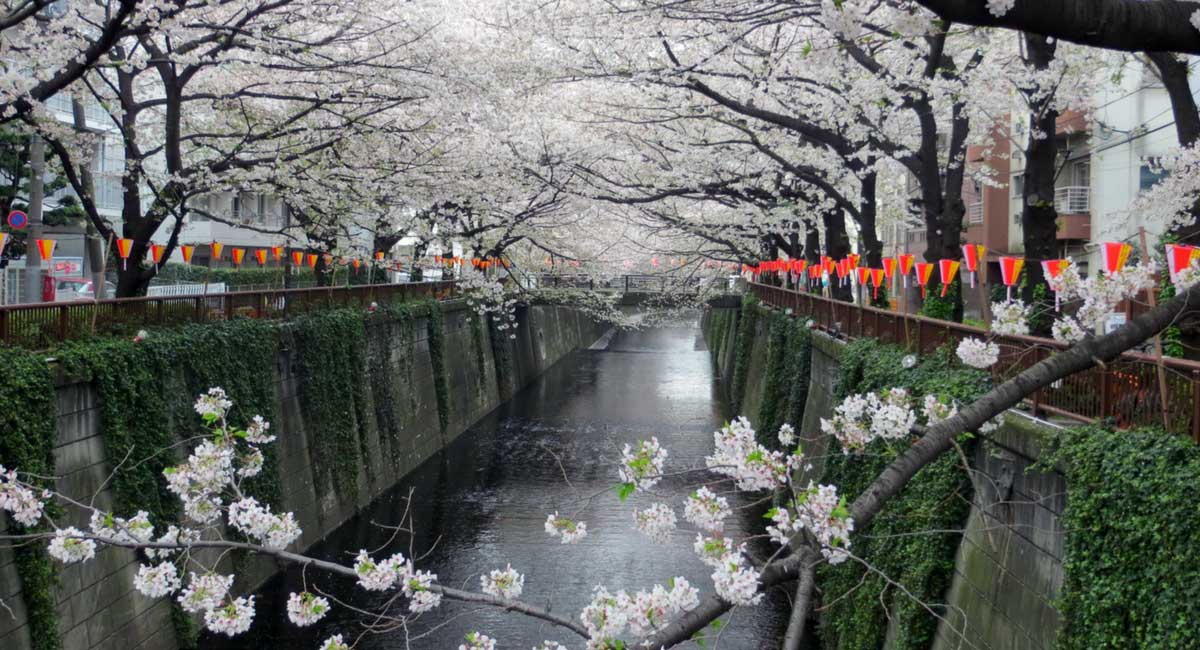
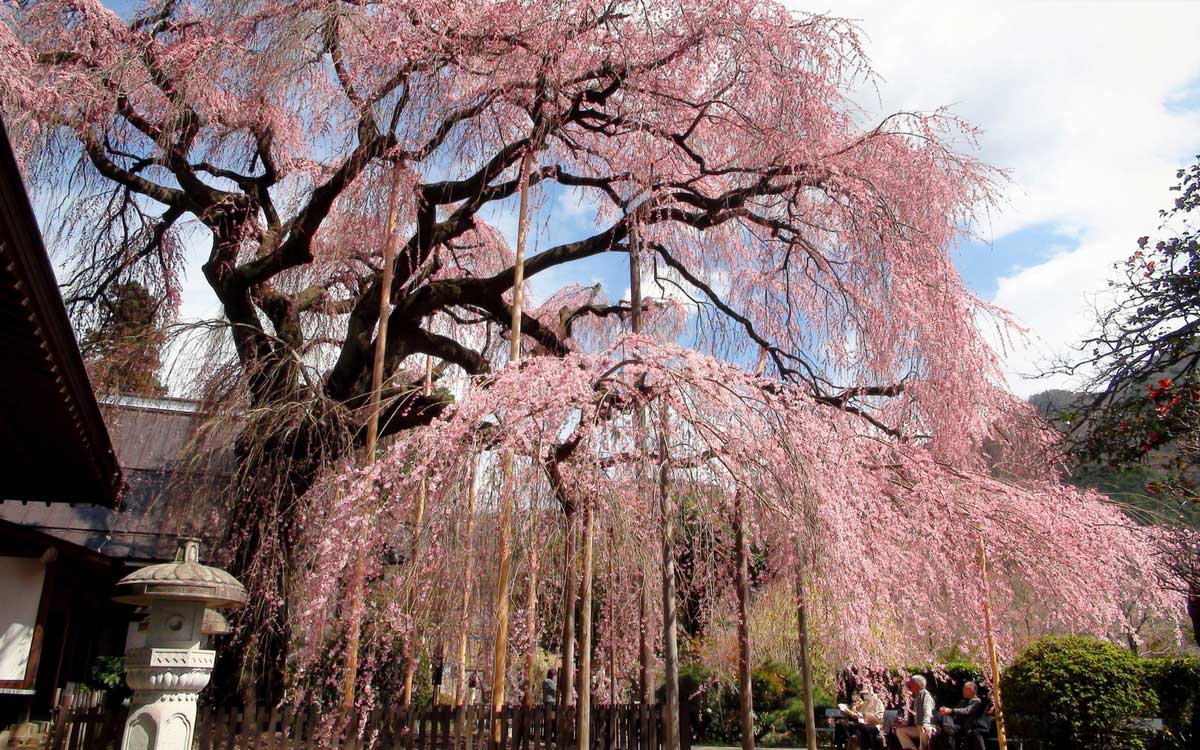
Comments